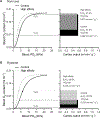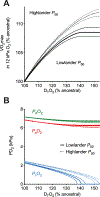Altitude acclimatization, hemoglobin-oxygen affinity, and circulatory oxygen transport in hypoxia
- PMID: 34879970
- PMCID: PMC8821351
- DOI: 10.1016/j.mam.2021.101052
Altitude acclimatization, hemoglobin-oxygen affinity, and circulatory oxygen transport in hypoxia
Abstract
In mammals and other air-breathing vertebrates that live at high altitude, adjustments in convective O2 transport via changes in blood hemoglobin (Hb) content and/or Hb-O2 affinity can potentially mitigate the effects of arterial hypoxemia. However, there are conflicting views about the optimal values of such traits in hypoxia, partly due to the intriguing observation that hypoxia-induced acclimatization responses in humans and other predominantly lowland mammals are frequently not aligned in the same direction as evolved phenotypic changes in high-altitude natives. Here we review relevant theoretical and empirical results and we highlight experimental studies of rodents and humans that provide insights into the combination of hematological changes that help attenuate the decline in aerobic performance in hypoxia. For a given severity of hypoxia, experimental results suggest that optimal values for hematological traits are conditional on the states of other interrelated phenotypes that govern different steps in the O2-transport pathway.
Keywords: Aerobic performance; High-altitude adaptation; Hypoxia; Oxygen transport pathway; VO(2max).
Copyright © 2021 Elsevier Ltd. All rights reserved.
Conflict of interest statement
Conflicts of interest: none
Figures






Similar articles
-
Hemoglobin-oxygen affinity in high-altitude vertebrates: is there evidence for an adaptive trend?J Exp Biol. 2016 Oct 15;219(Pt 20):3190-3203. doi: 10.1242/jeb.127134. J Exp Biol. 2016. PMID: 27802149 Free PMC article. Review.
-
Genetic variation in haemoglobin is associated with evolved changes in breathing in high-altitude deer mice.J Exp Biol. 2022 Jan 15;225(2):jeb243595. doi: 10.1242/jeb.243595. Epub 2022 Jan 19. J Exp Biol. 2022. PMID: 34913467 Free PMC article.
-
The adaptive benefit of evolved increases in hemoglobin-O2 affinity is contingent on tissue O2 diffusing capacity in high-altitude deer mice.BMC Biol. 2021 Jun 22;19(1):128. doi: 10.1186/s12915-021-01059-4. BMC Biol. 2021. PMID: 34158035 Free PMC article.
-
Phenotypic plasticity in blood-oxygen transport in highland and lowland deer mice.J Exp Biol. 2013 Apr 1;216(Pt 7):1167-73. doi: 10.1242/jeb.079848. Epub 2012 Dec 13. J Exp Biol. 2013. PMID: 23239893 Free PMC article.
-
Control of breathing and the circulation in high-altitude mammals and birds.Comp Biochem Physiol A Mol Integr Physiol. 2015 Aug;186:66-74. doi: 10.1016/j.cbpa.2014.10.009. Epub 2014 Oct 23. Comp Biochem Physiol A Mol Integr Physiol. 2015. PMID: 25446936 Review.
Cited by
-
Time Domains of Hypoxia Responses and -Omics Insights.Front Physiol. 2022 Aug 8;13:885295. doi: 10.3389/fphys.2022.885295. eCollection 2022. Front Physiol. 2022. PMID: 36035495 Free PMC article. Review.
-
Microevolutionary mechanism of high-altitude adaptation in Tibetan chicken populations from an elevation gradient.Evol Appl. 2022 Oct 31;15(12):2100-2112. doi: 10.1111/eva.13503. eCollection 2022 Dec. Evol Appl. 2022. PMID: 36540645 Free PMC article.
-
Association between hemoglobin concentration and hypertension risk in native Tibetans at high altitude.J Clin Hypertens (Greenwich). 2024 Jan;26(1):17-23. doi: 10.1111/jch.14726. Epub 2023 Sep 19. J Clin Hypertens (Greenwich). 2024. PMID: 37724706 Free PMC article.
-
Short-Term Intermittent Normobaric Hypoxia Combined with Light Exercise Improves Acclimatization of Cardiorespiratory Function in Inactive Adults.Open Access J Sports Med. 2024 Dec 17;15:229-237. doi: 10.2147/OAJSM.S492820. eCollection 2024. Open Access J Sports Med. 2024. PMID: 39717075 Free PMC article.
-
A near telomere-to-telomere phased reference assembly for the male mountain gorilla.Sci Data. 2025 May 22;12(1):842. doi: 10.1038/s41597-025-05114-5. Sci Data. 2025. PMID: 40404646 Free PMC article.
References
-
- Aste-Salazar H, Hurtado A. 1944. The affinity of hemoglobin for oxygen at sea level and at high altitudes. American Journal of Physiology 142, 733–743.
-
- Bencowitz HZ, Wagner PD, West JB. 1982. Effect of change in P50 on exercise tolerance at high-altitude - a theoretical study. Journal of Applied Physiology 53, 1487–1495. - PubMed
-
- Bouverot P 1985. Adaptation to Altitude-Hypoxia in Vertebrates. Berlin: Springer-Verlag.
-
- Calbet JAL, Boushel R, Radegran G, Sondergaard H, Wagner PD, Saltin B. 2003. Why is VO2max after altitude acclimatization still reduced despite normalization of arterial O2 content? American Journal of Physiology-Regulatory Integrative and Comparative Physiology 284, R304–R316. - PubMed
-
- Calbet JAL, Lundby C, Koskolou M, Boushel R. 2006. Importance of hemoglobin concentration to exercise: Acute manipulations. Respiratory Physiology & Neurobiology 151, 132–140. - PubMed
Publication types
MeSH terms
Substances
Grants and funding
LinkOut - more resources
Full Text Sources

